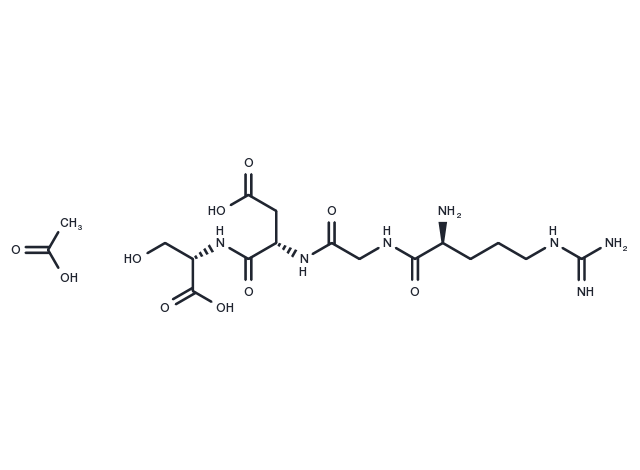keep away from moisture
Powder: -20°C for 3 years | In solvent: -80°C for 1 year

Arg-Gly-Asp-Ser acetate is an integrin binding sequence that directly and specifically bind pro-caspase-8, pro-caspase-9 and pro-caspase-3, while it does not bind pro-caspase-1. Arg-Gly-Asp-Ser acetate inhibits integrin receptor function.

| Pack Size | Availability | Price/USD | Quantity |
|---|---|---|---|
| 5 mg | In stock | $ 35.00 | |
| 10 mg | In stock | $ 47.00 | |
| 25 mg | In stock | $ 95.00 | |
| 50 mg | In stock | $ 159.00 | |
| 100 mg | In stock | $ 288.00 | |
| 200 mg | In stock | $ 433.00 |

| Description | Arg-Gly-Asp-Ser acetate is an integrin binding sequence that directly and specifically bind pro-caspase-8, pro-caspase-9 and pro-caspase-3, while it does not bind pro-caspase-1. Arg-Gly-Asp-Ser acetate inhibits integrin receptor function. |
| In vitro |
The RGDS-modified surface caused up-regulation of alpha(v)beta(3) integrin. Attachment to the RGDS-treated membrane completely abolished apoptosis induced by staurosporine, the Ca(2+).P(i) ion pair, and sodium nitroprusside. When the activity of the phosphatidylinositol 3-kinase pathway was inhibited, RGDS-dependent resistance to apoptosis was eliminated. These results indicated that the binding of cells to RGDS abrogated apoptosis via the mitochondrial pathway and that the suppression of apoptosis was dependent on the activity of phosphatidylinositol 3-kinase. RGDS interacts with survivin, as well as with procaspase-3, -8 and -9. Survivin, a known cell-cycle and survival-regulator is highly expressed in melanoma cells. RGDS-peptide binding to survivin was found to be specific, at high affinity (Kd 27.5 muM) and located at the survivin C-terminus. RGDS-survivin interaction appeared to play a key role, since RGDS lost its anti-mitogenic effect in survivin-deprived cells with a specific siRNA. |
| In vivo | Saline or LPS (1.5 mg/kg) was administered i.t. with or without a single dose of RGDS (1, 2.5, or 5 mg/kg, i.p.), anti-alphav or anti-beta3 mAb (5 mg/kg, i.p.). Mice were sacrificed 4 or 24 h post-LPS. |
| Synonyms | Arg-Gly-Asp-Ser acetate(91037-65-9 free base) |
| Molecular Weight | 493.47 |
| Formula | C17H31N7O10 |
| CAS No. | T10366L |
keep away from moisture
Powder: -20°C for 3 years | In solvent: -80°C for 1 year
DMSO: Slightly soluble
You can also refer to dose conversion for different animals. More
bottom
Please see Inhibitor Handling Instructions for more frequently ask questions. Topics include: how to prepare stock solutions, how to store products, and cautions on cell-based assays & animal experiments, etc.
Arg-Gly-Asp-Ser acetate T10366L Cytoskeletal Signaling Integrin Arg-Gly-Asp-Ser acetate(91037-65-9 free base) Arg Gly Asp Ser acetate Arg-Gly-Asp-Ser Acetate ArgGlyAspSer acetate inhibitor inhibit
